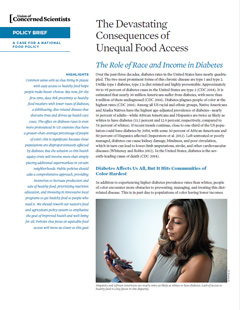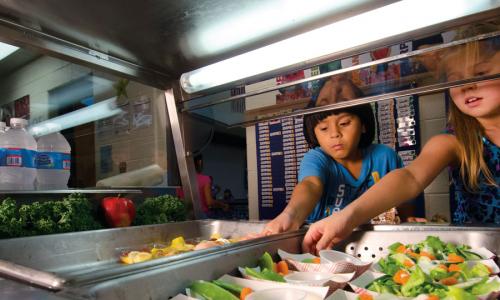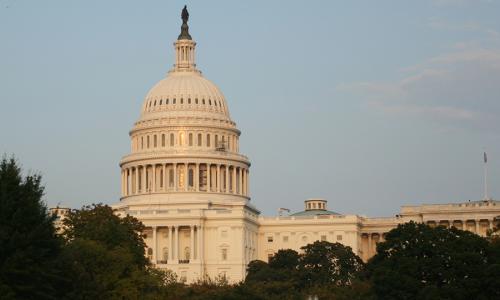Diabetes rates in the United States have nearly quadrupled over the past three decades. About 30 million people currently suffer from diabetes, and nearly 95 percent of these cases are type 2 diabetes, the diet-related form of the disease. If recent trends continue, close to one-third of the population could be diabetic by 2050. Untreated or poorly managed diabetes can lead to devastating and sometimes fatal complications: diabetes is currently the seventh leading cause of death in the United States.
Diets high in sugar, salt, and fat—and low in fiber, vitamins, and minerals, such as fruits, vegetables, and whole grains—increase the risk for type 2 diabetes. But what people eat is largely dependent on their access to various foods. Healthy food access is complex, and includes the physical environment (geographic proximity, transportation to food retailers, and availability); the economic environment (affordability); and the sociocultural environment (cultural taste preferences). Race and income are highly correlated with healthy food access—and with diabetes rates.
Diabetes and communities of color
Rising diabetes rates are a problem for everyone—but they have hit African American, Latino, and Native American communities hardest. Members of these communities are about twice as likely as whites to be diabetic, they face higher diabetes-related mortality rates, and they suffer disproportionately from complications such as kidney damage and lower-limb amputations.
Multiple causes drive these disparities. Lower incomes, combined with historical and perceived racism encountered in the health care system, make it harder for people of color to access both healthy food and health care. Barriers to health care access—including a shortage of community-based clinics, lack of personal transportation, and high out-of-pocket prescription drug costs—make diagnosing and managing diabetes particularly challenging in many communities of color.
Findings: food access, diabetes rates, race, and income
For this study, UCS examined one kind of access to healthy food—physical proximity—and its impact on diabetes rates. We looked at the most recent publicly available county-level data on retail food stores, food access, health outcomes, food insecurity, and socioeoconomic composition. Counties were categorized according to racial or economic composition: higher- vs. lower-than-average percentages of residents of color, and higher vs. lower income.
The study defined "healthy food retailers" as grocery stores, supercenters, farmers markets, and specialized food stores such as bakeries, meat and seafood markets, dairy stores, and produce markets, all of which reliably offer fresh and less-processed foods. "Unhealthy food retailers" were defined to include fast food restaurants and convenience stores, which offer a more limited selection of food centered on highly processed convenience items.
Here are some of the study's findings:
Access, race, and income. Counties with higher-than-average percentages of residents of color have both fewer healthy food retailers and more unhealthy food retailers. Lower-income counties had more unhealthy food retailers than higher-income counties, but the study found no difference by income in the number of healthy food retailers.
Access and diabetes rates. We found statistically significant correlations between food access and diabetes rates: greater access to healthy food is associated with lower diabetes rates, while greater access to unhealthy food is associated with higher diabetes rates.
Proximity to healthy food has a bigger impact in communities of color... The correlation between food access and diabetes rates is stronger in communities of color: both the positive effect of greater access to healthy food and the negative effect of greater access to unhealthy food were significantly larger than the national average in counties with higher-than-average percentages of residents of color.
...but a smaller one in lower-income communities. The effects of food access—both the positive effect of increased access to healthy food, and the negative effect of increased access to unhealthy food—were less pronounced in lower-income counties than higher-income counties. This suggests that lack of economic access can override physical access: the presence of a healthy food retailer in the neighborhood will not help people who can't afford to shop there.
Recommendations
Our study shows that increasing access to healthy food could help reduce diabetes rates, especially in communities of color. Unfortunately, current federal food policies, which encourage the production of unhealthy processed foods, are part of the problem. To make healthy food more available, accessible and affordable for people of color and low-income residents, we need a comprehensive transformation of our nation's food system—and this will require rethinking the policies that shape that system.
Access to healthy food is a multidimensional issue. Increasing the number of healthy food retailers in communities of color and low-income communities is an important step toward reducing diabetes rates and improving overall health in these communities, but the problem of equitable access to healthy food can't be solved with piecemeal remedies. Future federal policy needs to take a multifaceted approach that aims to accomplish the following:
- Bring more healthy food to the places where people of color and lower-income people live and gather. Encouraging healthy food retailers to build in underserved locations; creating and expanding food hubs and other distribution mechanisms; and changing nutrition assistance programs to encourage participants to purchase and consume more fruits and vegetables are a few ways to increase access.
- Prioritize culturally appropriate nutrition education for children, food service personnel, and parents. Eating habits are formed early in childhood, and in many cases schools are the best staging point for nutrition education. Using school meal programs to help children, parents, and food service personnel learn more about proper nutrition is a commonsense way to prime children for a lifetime of healthy eating.
- Create a comprehensive national food and farm policy that incorporates all of the above and more. In recent years, federal policies have taken important steps toward making the US food system more healthful and equitable. But current programs are still too small and piecemeal. The next president should commit to creating a comprehensive national food policy that would streamline and coordinate existing food, health, environmental, and economic objectives as a first step toward transforming the nation’s food system.







